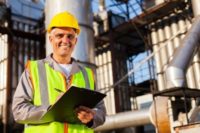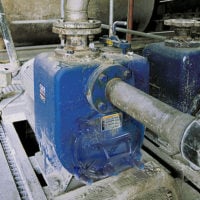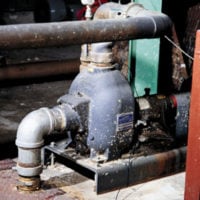Home » Blog » Picking the Perfect Pump...for your Pumping Application | Hayes Pump
Picking the Perfect Pump...for your Pumping Application | Hayes Pump
Choosing the correct Pump can mean the difference between consistent reliable operation versus downtime causing sometimes catastrophic consequences. This article outlines the steps and the considerations for ensuring you pick the perfect pump for your application. Special thanks to the original publisher, John Amundsen, District Manager at The Gorman–Rupp Company.
 Pumps and pumping systems are like unsung heroes of modern society – quickly and quietly transporting vital water supplies, chemicals and waste to and from locations, which rely upon their consistent, reliable operation. In fact, pumps and pumping systems are one of those entities that aren't typically noticed until a problem has arisen or downtime has occurred. This is especially true within the water and wastewater category, where the disruption of pumping operations has the ability to cause a variety of issues, from the inconvenient to the catastrophic. In many cases, however, by simply choosing the correct pump for the application, issues can be prevented.
Pumps and pumping systems are like unsung heroes of modern society – quickly and quietly transporting vital water supplies, chemicals and waste to and from locations, which rely upon their consistent, reliable operation. In fact, pumps and pumping systems are one of those entities that aren't typically noticed until a problem has arisen or downtime has occurred. This is especially true within the water and wastewater category, where the disruption of pumping operations has the ability to cause a variety of issues, from the inconvenient to the catastrophic. In many cases, however, by simply choosing the correct pump for the application, issues can be prevented.
When choosing the correct equipment for a pumping application, the choice can often be reduced to a handful of simple steps which – when followed carefully and thoroughly – can help eliminate much of the stress and confusion often involved with the equipment purchasing process. In addition, purchasing the correct pump ensures a longer pump life and greatly minimizes the occurrences of downtime. Purchasing the right pump for the job isn't like buying a pair of tennis shoes that will wear out in a year. This is a decision that you will have to live with for years, if not decades. Take your time and make sure you pick a pump that will not only do the job, but do it dependably and for years to come.
Find An Experienced Pump Distributor Partner
One of the most important steps along the way when purchasing new pumping equipment comes at the very beginning – choosing an expert with which to work. A distributor is often your key to uncovering the correct pump, because he will be the person to whom you provide information about your facility, your specific pumping application, the liquid being pumped, where it is being pumped to, how quickly it needs to be pumped – and a variety of other vital considerations.

A good pump distributor has the ability to compile each piece of information provided by you, put them together and end up with a clear picture of your pumping situation. From there they can then make an educated recommendation on the type of pumping equipment that will be best for your application.
The issue then becomes how to determine which distributor is the best. A telling indication of this is the number of years the professionals have been involved in the business, as well as the pump manufacturer they represent.
Typically, the more years they have been a distributor, the better. The number of years the distributor has been around is indicative of the quality of work that they do, because it simply takes years of experience working with pumps and pumping systems to fully understand the many intricacies and nuances that are involved in their use. This is not to say that someone with less time in the position can't do a fantastic job of accurately examining and diagnosing the correct equipment for your application. This certainly can be the case. However, it is often a much safer bet to fall back on the expertise of a distributor with time–tested experience.
Distributors who do poor work, make faulty recommendations and fail to back up their work with trustworthy dependability don't last long in the business. They quickly receive a reputation for sub–par work and are usually removed from working with the most dependable, trusted pump manufacturers – which tend to be many years in existence as well.
Know Your Pumping Application
Once a reliable equipment distributor has been secured, the problem or situation at hand must then be diagnosed. Throughout this process, it is absolutely vital to provide clear, concise and, above all else, factual information. Doing so is the only way to ensure that your organization receives the most appropriate piece of equipment for your application - trash pumps, solids pumps, dirty fluid pumps, clean liquid pumps, process pumps, or high viscosity pumps.
 Your distributor will request all of the information that you have about the pumping project. You should be prepared to provide exact data and information on the pumping location and the substance being pumped, including but not limited to; what liquid is being pumped, required flow rates, total head required, temperature, viscosity, specific gravity of the liquid, percentage and size of solids, etc. If you are purchasing replacement equipment for an ongoing application, you will also need to provide all information on the pumping application, including what type of pump is being replaced and why. If a material data safety sheet is available, it should also be supplied to the distributor. This information sharing stage is conducted in the interest of creating a picture for the distributor that allows for precise equipment recommendations.
Your distributor will request all of the information that you have about the pumping project. You should be prepared to provide exact data and information on the pumping location and the substance being pumped, including but not limited to; what liquid is being pumped, required flow rates, total head required, temperature, viscosity, specific gravity of the liquid, percentage and size of solids, etc. If you are purchasing replacement equipment for an ongoing application, you will also need to provide all information on the pumping application, including what type of pump is being replaced and why. If a material data safety sheet is available, it should also be supplied to the distributor. This information sharing stage is conducted in the interest of creating a picture for the distributor that allows for precise equipment recommendations.
In the instances when the wrong pump is supplied for an application, the result is often a major operational breakdown. Each pump contains both elastomers and metal components, making it vital to correctly match the elastomers needed for a pump with its metal components. For instance, some chemical substances have been known to swell or destroy the rubber components in the pump. Component deterioration (either elastomeric or metallic) is just one of the many examples of ways that pumping equipment can be irreparably damaged by being incorrectly matched with a liquid being pumped.
These types of mechanical failures lead to large amounts of wasted operational time and money that most facilities can ill afford. Warranties are also voided when the end user supplies incorrect information in the initial selection process.
Differentiate Between Pumps and Pumping Needs
 When supplied with all necessary information, an experienced pump distributor will have the ability to examine your specific applications and meet the needs of your project and budget with an appropriate piece of equipment. A seemingly endless number of differences separate one type of pump from another. Therefore, this step allows all options to be whittled down from a large list of potential pumps to one that will best fit the application.
When supplied with all necessary information, an experienced pump distributor will have the ability to examine your specific applications and meet the needs of your project and budget with an appropriate piece of equipment. A seemingly endless number of differences separate one type of pump from another. Therefore, this step allows all options to be whittled down from a large list of potential pumps to one that will best fit the application.
In a water or wastewater application, where trash of a varying nature can make its way into the system, any piece of pumping equipment being considered should pass solids that are at least 3–inches in diameter. Fish, debris, trash and other unmentionables can put even the best pump to the test in a wastewater environment. Most experienced facility engineers will know to look for 3" solids–passing abilities. However, smart engineers know better than to stop here.
 Centrifugal pumps account for nearly 90% of all pumps used in the primary wastewater pump application. Why? Because these hungry pumps are capable of handling large amounts of liquids and solids at any given point in time. In fact, when planning for wastewater applications, most municipalities focus on key flow times – typically between 6:00 a.m. and 9:00 a.m. In addition, they will look at times of traditionally high usage – such as during halftime of the Super Bowl. During these times, when waste systems are charged with processing peak flows, it is important to have self–priming centrifugal, heavy duty solids–handling technology.
Centrifugal pumps account for nearly 90% of all pumps used in the primary wastewater pump application. Why? Because these hungry pumps are capable of handling large amounts of liquids and solids at any given point in time. In fact, when planning for wastewater applications, most municipalities focus on key flow times – typically between 6:00 a.m. and 9:00 a.m. In addition, they will look at times of traditionally high usage – such as during halftime of the Super Bowl. During these times, when waste systems are charged with processing peak flows, it is important to have self–priming centrifugal, heavy duty solids–handling technology.
 Additionally, a peristaltic pump or hose pump is an ideal match for an application that requires smaller, more accurate measurements of viscous liquids to be pumped. However, this type of pump would never be needed in an application that moves large amounts of water at a high flow rate. In most cases, this type of equipment will be used in some type of metering or dosing application in a wastewater facility, such as assisting in the overall pumping application, serving to clean up mishaps, lower pH levels, inject chemicals as needed to maintain a safe and efficient environment, and more.
Additionally, a peristaltic pump or hose pump is an ideal match for an application that requires smaller, more accurate measurements of viscous liquids to be pumped. However, this type of pump would never be needed in an application that moves large amounts of water at a high flow rate. In most cases, this type of equipment will be used in some type of metering or dosing application in a wastewater facility, such as assisting in the overall pumping application, serving to clean up mishaps, lower pH levels, inject chemicals as needed to maintain a safe and efficient environment, and more.
Complex Pumping Application Distinctions
However, with more complex application requirements, a variety of potential solutions can present themselves. As I mentioned earlier it is crucial for you to be intimately familiar with the needs and applications of the pumping system. Often, the decision requires more investigation by the distributor because of the presence of multiple pump options. For example, many applications may seem to require a metering pump, many of which are of the mechanical diaphragm type. But, piston and progressive pumps can also be utilized for specific applications – usually requiring higher flows.
Pump construction materials also play a factor. Most common materials of construction for these types of pump would be Buna, Viton or Teflon diaphragms by DuPont. Buna is a Butadiene Acrylo–Nitril rubber compound with a maximum temperature rating of 240 degrees F. Viton is a fluorinated hydrocarbon compound with a maximum temperature rating of 400 – 600 degrees F. Teflon is a tetrafluoro–ethylene resin compound is also used in pump diaphragms for abrasive/corrosive applications with a maximum temperature rating of 450 degrees F. Other appropriate materials, depending on the liquid being pumped, would include various stainless steels, or other nonmetallic substances.
Different Pump Solutions
Although there are ways to help ensure the pump purchasing process is made simpler and more effective, there is no clear–cut set of circumstances that call for one pump over another. Each pumping application carries its own unique set of considerations and conditions, which must be evaluated as a part of the overall selection process.
This is the reason that a pump distributor is so valuable – for their ability to take all factors into consideration. A responsible distributor will always make the smartest recommendation for their clients. Additionally, the most reliable distributors are typically associated with the most reliable pump manufacturers.
At times that may mean recommending a piece of equipment that will have a higher upfront cost. While these initial costs may be slightly more than other pieces of equipment, the equipment is usually considered to be a smarter long–term investment – as it will lead to less downtime and lower maintenance costs in the future.
The pump purchasing process can be a long and arduous one. In order to reach a quick conclusion, you must partner with an experienced, reliable distributor – and be careful to supply him or her with the most comprehensive, detailed information possible. This way, you are likely to make it a more successful experience for you as well as the equipment supplier and manufacturer.



